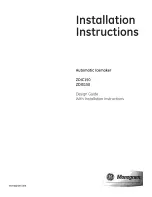
Know your ingredients
Understanding baking
It is often said that cooking is an art relying on the
creativity of the chef while baking bread is much
more of a science. This means that the process of
combining flour, water and yeast results in a reaction
that produces bread. You have to remember that
when the ingredients combine with each other they
produce a specific result. Read the following
information carefully to gain a better understanding of
the importance each ingredient plays in the
breadmaking process.
Important note on flours
Flours, while visibly similar, can be very different
by virtue of how they were grown, milled, stored, etc.
You may find that you will have to experiment with
different brands of flour to help you make that perfect
loaf. Storage is also very important, as all flours
should be kept in an airtight container.
All purpose flour/plain flour
All purpose Flour is a blend of refined hard and
soft wheat flours especially suitable for making cake.
This type of flour should be used for recipes in the
cake/quick bread section.
Strong white flour/bread flour
Bread flour is a high gluten/protein flour that has
been treated with conditioners that give dough a
greater suitability for kneading. Bread Flour typically
has a higher gluten concentration than All purpose
flour; however, depending on different milling
practices, this may vary. Strong plain flour or bread
flour are recommended for use with this breadmaker.
Whole wheat flour/wholemeal flour
Whole wheat flour/wholemeal flour is milled from
the entire wheat kernel which contains the bran and
germ and makes it heavier and richer in nutrients
than white flour. Breads made with this flour are
usually smaller and heavier than white loaves. To
overcome this whole wheat flour/wholemeal flour can
be mixed with Bread flour or strong plain flour to
produce a high light textured bread.
Self-raising flour
Self-raising Flour contains unnecessary leavening
ingredients that will interfere with bread and cake
making. It is not recommended for use.
Bran
Bran (unprocessed) & Wheat Germ are the coarse
outer portions of the wheat or rye grains separated
from flour by sifting or bolting. They are often added
in small quantities to bread for nutritional enrichment,
heartiness and flavour. They are also used to
enhance the texture of bread.
Oatmeal
Oatmeal comes from rolled or steel-cut oats. They
are used primarily to enhance flavour and texture.
Other ingredients
Yeasts (active dry yeast)
Yeast through a fermentation process produces gas
(carbon dioxide) necessary to make the bread rise.
Yeast must be able to feed on sugar and flour
carbohydrates in order to produce this gas. Fast action
granular yeast is used in all recipes that call for yeast.
There are basically three different types of yeast
available, fresh, traditional dry active and fast action.
It is recommended that fast action yeast be
used.
Fresh or compressed cake yeast is not
recommended as they will produce poor results. Store
yeast according to manufacturers instructions. Ensure
your yeast is fresh by checking its expiration date. Once
a package or can of yeast is opened it is important that
the remaining contents be immediately resealed and
refrigerated as soon as possible for future use. Often
bread or dough, which fails to rise, is due to stale yeast
being used. The following test can be used to
determine whether your yeast is stale and inactive:
1
Place half a cup of lukewarm water into a small
bowl or cup.
2
Stir 1 tsp. of sugar into the water then sprinkle 2
tsp. of yeast over the surface.
3
Place bowl or cup in a warm area and allow to sit
for 10 minutes undisturbed.
4
The mixture should foam and produce a strong
yeast aroma. If this does not occur, discard
mixture and start again with another packet of
dried yeast.
Sugar
Sugar is important for the colour and flavour of
breads. It is also food for the yeast as it is part of the
fermentation process. Artificial sweeteners cannot be
used as a substitute for sugar as the yeast will not react
properly with them.
Salt
Salt is necessary to balance the flavour of breads
and cakes, as well as for the crust colour that develops
during baking. Salt also limits the growth of yeast so
the amounts shown in the recipes should not be
increased. For dietary reasons it may be reduced,
however, your baking may suffer.
11











































